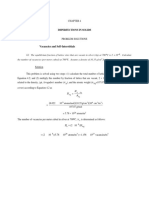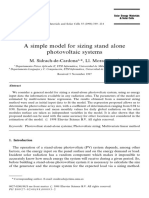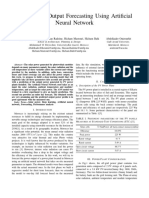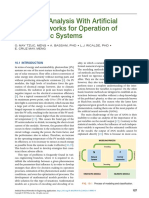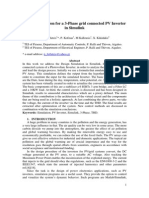The Retscreen Model For Assessing Potential PV Projects
Uploaded by
Sara PotterThe Retscreen Model For Assessing Potential PV Projects
Uploaded by
Sara PotterPJ Hori:on.
Workshop on Photovoltaic Hvbrid Svstems, Montreal, September 10, 2001
THE RETSCREEN MODEL FOR ASSESSING POTENTIAL PV PROJECTS
Didier Thevenard
Numerical Logics Inc., Waterloo, ON, Canada
Gregory Leng and Sylvain Martel
CANMET Energy Diversification Research Laboratory (CEDRL), Varennes, QC, Canada
ABSTRACT
The RETScreen software was developed to assist in the
preliminary assessment of potential renewable energy
projects. First released for on-grid applications, the
RETScreen PV model was recently upgraded to cover off-
grid applications. These include stand-alone, hybrid and
water pumping systems. The program guides the users in
the design of their systems, by providing initial estimates
of array, battery, or pump size. By changing a few of the
systems parameters, users are able to quickly screen the
most effective technology and system size depending on
load, climatic conditions, and season of use. This paper
describes various models (radiation, array, battery, whole
system) used to predict energy production from PV
systems, given climatic variables and system parameters.
INTRODUCTION
RETScreen International is an innovative and unique
renewable energy awareness, decision-support and
capacity-building tool developed by Natural Resources
Canadas CEDRL with the contribution of 85 experts from
industry, government and academia. Collaborating
organizations include the United Nations Environment
Programme (UNEP) and the National Aeronautics &
Space Administration (NASA). RETScreen is provided
free-of-charge to users around the world [1].
The core of the tool consists of a standardised and
integrated renewable energy project analysis software that
can be used worldwide to evaluate the energy production,
life-cycle costs and greenhouse gas emission reductions
for various types of renewable energy technologies
(RETs), including photovoltaics. The software consists of
easy-to-use Microsoft Excel spreadsheets. In addition to
the software, the tool includes: product, weather and cost
databases; an online manual; a website; project case
studies; and a training course. RETScreen provides a
common platform for evaluating project proposals while
significantly reducing the costs associated with preparing
preliminary feasibility studies. In addition, the tool is ideal
for educational and industry/market development
purposes.
First released in 1998 for on-grid applications, the
RETScreen PV model was recently upgraded to also
cover off-grid PV applications. These include stand-alone,
hybrid and water pumping systems. This paper details the
various models used to calculate, on a month-by-month
basis, the energy production of PV systems in
RETScreen. They include a new model to compute solar
radiation in the plane of the PV array, given monthly mean
daily solar radiation on a horizontal surface; a model to
calculate PV array efficiency given ambient temperature
and available solar radiation; a simplified battery model
taking into account variations of battery efficiency with
temperature and rate of charge; and finally models making
use of the concept of utilizability, as well as models
developed from simulations, to evaluate the interaction of
the various components of the system and predict how
much energy (or water, in the case of a pumping system)
can be expected from the system on an annual basis.
SOLAR RADIATION MODEL
The output of PV systems depends strongly on the
average daily solar radiation incident upon the array,
which in turn depends on its orientation and tilt. However,
values of solar radiation are most often reported for
horizontal surfaces (this is also true for the values
provided by the on-line weather database of RETScreen),
therefore converting monthly average horizontal radiation
values to their plane-of-array equivalent is the first task
faced by the program.
The problem is not new and has been treated by several
authors (see [2]). However the situation is made more
challenging in RETScreen due to the fact that both fixed
and tracking configurations are considered. For that
reason a new algorithm inspired by the work of Klein and
Theilacker [2] was developed. The algorithm can be
described as a succession of three basic steps:
1. Calculate hourly direct irradiance and diffuse irradiance
on an horizontal surface for all hours of an 'average day'
having the same daily global irradiance as the monthly
average. This is achieved through the use of classical
formulae first derived by Erbs, Collares-Pereira and Rabl,
and Liu and Jordan (all described in [2]).
2. Calculate hourly values of global irradiance on the tilted
(or tracking) surface for all hours of the day. This is done
with a simple isotropic model. For tracking surfaces (one-
PJ Hori:on. Workshop on Photovoltaic Hvbrid Svstems, Montreal, September 10, 2001
axis, two-axis or azimuth) the tracking angles are
determined with the formulae of Braun and Mitchell [3].
3. Sum the above to obtain the average daily irradiance in
the plane of the PV array (note that the sum is not
calculated analytically, as was done in the original work of
Klein and Theilacker, because this proves unpractical for
tracking surfaces).
Despite its relative simplicity, the above algorithm works
well when compared to full hourly simulations. Tests for
various fixed and tracking surfaces and for sites ranging
from the equator to the Canadian arctic revealed that the
accuracy of the algorithm is below 4 % (in an RMS sense)
for equator-facing surfaces tilted with an angle equal to the
latitude, and below 7 % for tracking surfaces. For vertical
east- and west-facing surfaces the RMS error may be as
high as 9 %. Even then, the accuracy of the algorithm is
considered to be sufficient for preliminary feasibility
studies. Given that the model only requires the user to
input 12 monthly data, as opposed to 8,760 for hourly
simulations, the small reduction in accuracy is more than
compensated for due to its ease-of-use and cost savings
for the PV industry.
ARRAY MODEL
The PV array model is based on work by Evans [4] and is
common to all types of PV systems represented in
RETScreen. The array is characterized by its efficiency,
p
, which is a function of its nominal efficiency,
r
,
measured at a reference temperature C 25 =
r
T :
( ) [ ]
r c r p
T T = 1 (1)
where is the temperature coefficient for module
efficiency and
c
T is the module temperature.
c
T is related
to the mean monthly ambient temperature
a
T through
Evans formula [4]:
( )
800
20
832 219
+ =
NOCT
K T T
t a c
(2)
where
t
K is the clearness index. NOCT is the Nominal
Operating Cell Temperature, which is characteristic of the
type of module under consideration. Equation (2) is valid
for optimally tilted arrays facing the equator. In other
configurations a small correction is applied, depending on
the actual tilt of the array, as described in [4]. The same
correction is applied in the case of tracking surfaces, using
the tilt angle at noon as the actual tilt angle.
The array efficiency calculated by Equ. 1 has to be
reduced by two factors. The first one,
p
, represents
miscellaneous array losses such as losses due to dirt or
snow covering the modules. The second,
c
, represents
various power conditioning losses such as those due to
DC to DC converters or step-up transformers. The array
power available to the load and the battery,
A
E , is
therefore:
( )( )
c p p t A
H E = 1 1 (3)
where
t
H is the solar radiation incident upon the array.
MODEL FOR ON-GRID SYSTEMS
The grid-connected model is the simplest system model.
The energy available to the grid is what is produced by the
array, reduced by inverter losses:
inv A grid
E E = (4)
where
inv
is the inverter efficiency. Depending on the grid
configuration not all this energy may be absorbed by the
grid. The energy actually delivered
dlvd
E is:
abs grid dlvd
E E = (5)
where
abs
is the PV energy absorption rate, equal to 1 for
large grids, and ranging between 0.95 and 0.98 for small
grids.
MODEL FOR OFF-GRID SYSTEMS
The off-grid model represents stand-alone systems with a
battery backup, with or without an additional genset. The
conceptual framework of the model is shown in Fig. 1.
Energy from the PV array is either used directly by the
load, or goes through the battery before being delivered to
the load. The remainder of the load is provided by the
genset if there is one, that is, stand-alone and hybrid
systems differ only by the presence of a genset that
supplies the part of the load not met directly or indirectly
by photovoltaics.
PV array
efficiency
(p)
Other power
conditioning
losses
(1-c)
Misc. PV array
losses
(1-p)
Charge controller
efficiency
(c)
Battery efficiency
(b)
Fraction PV
(fpv)
Load
Genset efficiency
(G)
EP
Ht
EA
ES
EB EG
ED
L
Fuel
Charger efficiency
(R)
Battery efficiency
(b)
Fig. 1 RETScreen model for off-grid systems
PJ Hori:on. Workshop on Photovoltaic Hvbrid Svstems, Montreal, September 10, 2001
Load
The user specifies the total DC demand,
DC
D , and the
total AC demand,
AC
D . This latter is converted to a DC
equivalent by dividing it by the average inverter efficiency
inv
. Hence the total equivalent DC demand
equ DC
D
,
is:
inv
AC
DC equ DC
D
D D
+ =
,
(6)
RETScreen pays great attention to the correlation
between load and solar resource. The equivalent DC
demand is broken down into:
bat cont match equ DC
D D D D + + =
,
(7)
where
match
D is the part of the demand that is met directly
by the PV modules only when there is enough energy
produced (e.g. fan directly coupled to the PV module);
cont
D is the part of the demand that is constant throughout
the day (e.g. cathodic protection, monitoring system); and
bat
D is the part of the demand that will be met primarily by
the battery (e.g. night-time loads, or daytime intermittent
loads such as a refrigerator).
Continuous and matched demand
The continuous demand
cont
D is met either directly by the
PV modules (during the day when there is enough
sunshine) or through the battery (at night, or when there is
not enough sunshine). The fraction of monthly radiation
that falls above a certain level needed to meet the
continuous load is called the monthly average daily
utilizability . The concept of utilizability has been long
used to estimate the performance of active solar systems,
and can readily be estimated from the monthly average
clearness index and the continuous load (although the
algorithm is too complicated to fit in the space allocated to
this paper; see [2] for details). The energy delivered
directly to the continuous load is simply:
( )
A cont
E E = 1 (8)
while the energy delivered to the matched load is:
( )
cont A match match
E E D E = , min (9)
The energy delivered directly to the load is therefore:
match cont D
E E E + = (10)
and the energy delivered to the battery is:
D A
E E (11)
Demand met primarily through the battery
The fraction of the load that a system with battery backup
will provide depends on the size of the array and the
battery, relative to the load. An estimate of this fraction
was obtained from correlations derived from simulations.
Using WATSUN-PV, an hourly simulation program for
photovoltaic systems [5], a number of simulations were
run for a dummy stand-alone system with night-only load,
with weather data from six locations corresponding to a
variety of climates (Toronto, Vancouver, Edmonton,
Phoenix, Miami, Denver). Various array sizes were used
and the battery capacity was varied from one to six days
of storage.
Figure 2 shows in graphical form the output of the
simulations providing, on a monthly basis, the fraction of
the load met by the PV system,
PV
f , given the
storage/load ratio SLR and the array/load ratio ALR .
ALR and SLR are defined as:
L E ALR
A
= (12)
L Q SLR
U
= (13)
where L is the part of the load not met directly by the PV
system:
D
E L L = (14)
and
A
E is the available array output reduced by the
energy delivered directly to the load, and then by the
charge controller efficiency
c
and battery efficiency
b
:
( )
b c D A A
E E E = (15)
0.0
0.1
0.2
0.3
0.4
0.5
0.6
0.7
0.8
0.9
1.0
fPV
0 0.26 0.51 0.77 1.02 1.28 1.53 1.79 2.04 2.3 2.55 2.81
1.00
1.75
4.00
ALR
SLR
Fig. 2 Fraction of load supplied by PV, given the
array/load and storage/load ratios.
The usable battery capacity
U
Q is related to the nominal
capacity
B
Q :
B B U
Q f Q = (16)
PJ Hori:on. Workshop on Photovoltaic Hvbrid Svstems, Montreal, September 10, 2001
where
B
f is a factor dependent on battery temperature
B
T and discharge rate r , as shown in Figure 3. Battery
temperature is set by the user either to a fixed value or to
ambient. The discharge rate is taken as n 24 where n is
the number of days of autonomy.
A tabulated version of the surface of Figure 2 is
incorporated into RETScreen, and the demand met
through the battery is given by:
( )
D PV B
E L f E = (17)
0
20
40
60
80
100
120
-40 -30 -20 -10 0 10 20 30 40 50
Discharge temperature (C)
P
e
r
c
e
n
t
o
f
2
5
C
d
i
s
c
h
a
r
g
e
d
c
a
p
a
c
i
t
y
d
e
l
i
v
e
r
e
d
0.5
5
50
100
500
Discharge rate
(hours)
Fig. 3 Usable battery capacity as a function of discharge
rate and temperature (derived from [6]).
Demand met by the genset
The energy delivered by the genset,
G
E , is simply the
difference between the load and what can be provided by
the PV array, either directly or through the battery:
B D G
E E L E = (18)
Energy delivered
Energy delivered to the load is the sum of the demands
met by the batteries, by the genset, and directly by the
array:
G B D dlvd
E E E E + + = (19)
MODEL FOR WATER-PUMPING SYSTEMS
The water pumping model is based on simple equations
found in [7]. Given a required daily volume of water Q (in
m
3
/d) that has to be lifted to a height h (in m), the daily
hydraulic energy demand
hydr
E (in J) is:
( )
f hydr
h Q g E + = 1 86400 (20)
where g is the acceleration of gravity (9.81 m s
-2
), the
density of water (1000 kg m
-3
), and
f
is a factor
accounting for friction losses in the piping. Given the pump
system efficiency
pump
, this hydraulic energy translates
into an electrical energy requirement
pump
E :
pump
hydr
pump
E
E
= (21)
Energy delivered is simply:
( )
A pump pump dlvd
E E E , min = (22)
where
A
E is the energy available from the array.
CONCLUSION
The models described in this paper provide a set of
equations that lend themselves well to an efficient
spreadsheet implementation. The incorporation of these
models into RETScreen makes it possible to compare
quickly the benefits of solar photovoltaic systems to those
of conventional energy sources. The models go into
enough detail that meaningful physical phenomena are
taken into account, while at the same time retaining
enough simplicity to minimize data input requirements for
users. The small reduction in accuracy due to the use of
monthly data, rather than hourly data used in most other
PV simulation models, is more than compensated for due
to its ease-of-use and cost savings for the PV industry.
The accuracy of the new RETScreen PV model is
considered to be sufficient for preliminary feasibility
studies.
REFERENCES
[1] Leng G et al., RETScreen Renewable Energy Project
Analysis Software. Available free-of-charge from
NRCan/CEDRL at http://retscreen.gc.ca
[2] Duffie J and Beckman W, Solar Engineering of Thermal
Processes, 2nd edition (1991). John Wiley & Sons.
[3] Braun JE and Mitchell JC, Solar Geometry for fixed and
Tracking Surfaces. Solar Energy 31,5 (1983) 439-444.
[4] Evans DL, Simplified method for predicting photovoltaic
array output. Solar Energy 27,6 (1981) 555-560.
[5] WATSUN-PV 6.1, Department of Systems Design
Engineering, University of Waterloo, Waterloo, ON,
Canada N2L 3G1.
[6] CANMET (1991). Photovoltaic systems design manual.
Natural Resources Canada, CANMET, 580 Booth Street,
Ottawa, Ontario, Canada K1A 0E4.
[7] Royer J, Djiako T, Schiller E, and Sy BS, Le pompage
photovoltaque: manuel de cours a lintention des
ingnieurs et des techniciens (1998). Institut de lnergie
des Pays ayant en commun lusage du Franais, 56, rue
Saint-Pierre, 3
e
tage, Qubec, QC, Canada G1K 4A1.
You might also like
- Design and Control Strategies of PV-Diesel Systems Using Genetic AlgorithmsNo ratings yetDesign and Control Strategies of PV-Diesel Systems Using Genetic Algorithms19 pages
- A New Simple Analytical Method For Calculating The Optimum Inverter Size in Grid Connected PV PlantsNo ratings yetA New Simple Analytical Method For Calculating The Optimum Inverter Size in Grid Connected PV Plants8 pages
- Regular Paper Stand-Alone PV System Simulation For DG Applications, Part I: PV Module Modeling and Inverters Adel El ShahatNo ratings yetRegular Paper Stand-Alone PV System Simulation For DG Applications, Part I: PV Module Modeling and Inverters Adel El Shahat19 pages
- A Step by Step Technique For Using SimulNo ratings yetA Step by Step Technique For Using Simul10 pages
- Ensemble of constraint handling techniques for PV parameter extraction using differential evolutionary algorithmsNo ratings yetEnsemble of constraint handling techniques for PV parameter extraction using differential evolutionary algorithms9 pages
- A novel algorithm for optimal sizing of stand-alone photovoltaic pumping systemsNo ratings yetA novel algorithm for optimal sizing of stand-alone photovoltaic pumping systems10 pages
- Optimal Configuration of Hybrid Solar-Wind Distributed Generation Capacity in A Grid-Connected MicrogridNo ratings yetOptimal Configuration of Hybrid Solar-Wind Distributed Generation Capacity in A Grid-Connected Microgrid6 pages
- Power Balancing Control For AC/DC MicrogridNo ratings yetPower Balancing Control For AC/DC Microgrid8 pages
- 2014 Perez Gallardo J.R. Aguilar Lasserre A. Renew. EnergyNo ratings yet2014 Perez Gallardo J.R. Aguilar Lasserre A. Renew. Energy16 pages
- A Simple Model For Sizing Stand Alone PHOTOVOLTAIC SYSTEMSNo ratings yetA Simple Model For Sizing Stand Alone PHOTOVOLTAIC SYSTEMS16 pages
- Grid-Tied System Modelling: and Why: PV HOWNo ratings yetGrid-Tied System Modelling: and Why: PV HOW4 pages
- Accurate MATLAB Simulink PV System Simulator Based On A Two-Diode ModelNo ratings yetAccurate MATLAB Simulink PV System Simulator Based On A Two-Diode Model9 pages
- Optimal Design of A Hybrid Solar - Wind-Diesel Power System For Rural Electrification Using Imperialist Competitive AlgorithmNo ratings yetOptimal Design of A Hybrid Solar - Wind-Diesel Power System For Rural Electrification Using Imperialist Competitive Algorithm9 pages
- Comparison of PV Panels MPPT Techniques Applied To Solar Water Pumping SystemNo ratings yetComparison of PV Panels MPPT Techniques Applied To Solar Water Pumping System10 pages
- A Comparative Study of PV Models in Matlab/SimulinkNo ratings yetA Comparative Study of PV Models in Matlab/Simulink6 pages
- Design and Simulation of A PV System With Battery Storage Using Bidirectional DC DC Converter Using Matlab SimulinkNo ratings yetDesign and Simulation of A PV System With Battery Storage Using Bidirectional DC DC Converter Using Matlab Simulink8 pages
- Simulation Model Developed For A Small-Scale PV System in Distribution NetworksNo ratings yetSimulation Model Developed For A Small-Scale PV System in Distribution Networks6 pages
- An efficient of estimation the load profile analysis of photo voltaic system with different shading of local cityNo ratings yetAn efficient of estimation the load profile analysis of photo voltaic system with different shading of local city9 pages
- Development of A MATLAB/Simulink Model of A Single-Phase Grid-Connected Photovoltaic SystemNo ratings yetDevelopment of A MATLAB/Simulink Model of A Single-Phase Grid-Connected Photovoltaic System8 pages
- Variation of Radio Refractivity With Season A Case Study of Ikeja Lagos State NigeriaNo ratings yetVariation of Radio Refractivity With Season A Case Study of Ikeja Lagos State Nigeria9 pages
- Improving The Performance of Photovoltaic Module During Partial Shading Using ANNNo ratings yetImproving The Performance of Photovoltaic Module During Partial Shading Using ANN8 pages
- Design Optimization of Solar Power System With Respect To Temperature and Sun TrackingNo ratings yetDesign Optimization of Solar Power System With Respect To Temperature and Sun Tracking5 pages
- Understanding Solar Photovoltaic System Performance - USNo ratings yetUnderstanding Solar Photovoltaic System Performance - US34 pages
- Sensitivity Analysis With Artificial Neutal Networks For Operation of Photovoltaic SystemsNo ratings yetSensitivity Analysis With Artificial Neutal Networks For Operation of Photovoltaic Systems12 pages
- Design Hybrid Solar-Wind-Diesel Power SysNo ratings yetDesign Hybrid Solar-Wind-Diesel Power Sys6 pages
- Analysis of Solar Direct Irradiance Models Under Clear-Skies: Evaluation of The Improvements For Locally Adapted ModelsNo ratings yetAnalysis of Solar Direct Irradiance Models Under Clear-Skies: Evaluation of The Improvements For Locally Adapted Models49 pages
- Design Simulation For A 3 Phase Grid Connected PV Inverter in Simulink PDFNo ratings yetDesign Simulation For A 3 Phase Grid Connected PV Inverter in Simulink PDF9 pages
- 3-A Comprehensive Review and Classified Comparison of MPPT Algorithms in PV Systems-21No ratings yet3-A Comprehensive Review and Classified Comparison of MPPT Algorithms in PV Systems-2140 pages
- Development of A MATLABSimulink Model of A Single-Phase Grid-Connected Photovoltaic System-IwQNo ratings yetDevelopment of A MATLABSimulink Model of A Single-Phase Grid-Connected Photovoltaic System-IwQ8 pages
- TRNSYS Modeling of The Segs VI Parabolic Trough Solar Electric Generating SystemNo ratings yetTRNSYS Modeling of The Segs VI Parabolic Trough Solar Electric Generating System8 pages
- Model and Validation of Single-Axis Tracking With Bifacial PVNo ratings yetModel and Validation of Single-Axis Tracking With Bifacial PV8 pages
- Economic Dispatch For A Microgrid Considering Renewable Energy Cost FunctionsNo ratings yetEconomic Dispatch For A Microgrid Considering Renewable Energy Cost Functions7 pages
- A Novel Adaptive Filtering Algorithm Based Parameter Estimation Technique For Photovoltaic SystemNo ratings yetA Novel Adaptive Filtering Algorithm Based Parameter Estimation Technique For Photovoltaic System9 pages
- Maximum Power Point Tracking Using Fuzzy Logic Controller Under Partial ConditionsNo ratings yetMaximum Power Point Tracking Using Fuzzy Logic Controller Under Partial Conditions14 pages
- 2008-Garcia Review Codes Central ReciverNo ratings yet2008-Garcia Review Codes Central Reciver9 pages
- A New Hybrid Photovoltaic-Diesel System Control Scheme For An Isolated LoadNo ratings yetA New Hybrid Photovoltaic-Diesel System Control Scheme For An Isolated Load12 pages
- A Model For Predicting Photovoltaic Module PerformancesNo ratings yetA Model For Predicting Photovoltaic Module Performances9 pages
- A Case Study for a Single-Phase Inverter Photovoltaic System of a Three-Bedroom Apartment Located in Alexandria, Egypt: building industry, #0From EverandA Case Study for a Single-Phase Inverter Photovoltaic System of a Three-Bedroom Apartment Located in Alexandria, Egypt: building industry, #0No ratings yet
- Modeling of Photovoltaic Systems Using MATLAB: Simplified Green CodesFrom EverandModeling of Photovoltaic Systems Using MATLAB: Simplified Green CodesNo ratings yet
- Mathematics Department HKUGA College: Total: 50 MarksNo ratings yetMathematics Department HKUGA College: Total: 50 Marks8 pages
- Dynamic Stiffness Optimization Using Radioss PDFNo ratings yetDynamic Stiffness Optimization Using Radioss PDF11 pages
- Mekanika Fluida I (Fluid Mechanics) : Oleh Ir. H. Nefli Yusuf, M.EngNo ratings yetMekanika Fluida I (Fluid Mechanics) : Oleh Ir. H. Nefli Yusuf, M.Eng29 pages
- Steam Table For Compressed Liquid & Superheated Steam PDFNo ratings yetSteam Table For Compressed Liquid & Superheated Steam PDF60 pages
- Getting Started With Maple: Simple Calculations100% (1)Getting Started With Maple: Simple Calculations5 pages
- Brawn Laboratories Limited: Standard Operating ProcedureNo ratings yetBrawn Laboratories Limited: Standard Operating Procedure4 pages
- Design and Control Strategies of PV-Diesel Systems Using Genetic AlgorithmsDesign and Control Strategies of PV-Diesel Systems Using Genetic Algorithms
- A New Simple Analytical Method For Calculating The Optimum Inverter Size in Grid Connected PV PlantsA New Simple Analytical Method For Calculating The Optimum Inverter Size in Grid Connected PV Plants
- Regular Paper Stand-Alone PV System Simulation For DG Applications, Part I: PV Module Modeling and Inverters Adel El ShahatRegular Paper Stand-Alone PV System Simulation For DG Applications, Part I: PV Module Modeling and Inverters Adel El Shahat
- Ensemble of constraint handling techniques for PV parameter extraction using differential evolutionary algorithmsEnsemble of constraint handling techniques for PV parameter extraction using differential evolutionary algorithms
- A novel algorithm for optimal sizing of stand-alone photovoltaic pumping systemsA novel algorithm for optimal sizing of stand-alone photovoltaic pumping systems
- Optimal Configuration of Hybrid Solar-Wind Distributed Generation Capacity in A Grid-Connected MicrogridOptimal Configuration of Hybrid Solar-Wind Distributed Generation Capacity in A Grid-Connected Microgrid
- 2014 Perez Gallardo J.R. Aguilar Lasserre A. Renew. Energy2014 Perez Gallardo J.R. Aguilar Lasserre A. Renew. Energy
- A Simple Model For Sizing Stand Alone PHOTOVOLTAIC SYSTEMSA Simple Model For Sizing Stand Alone PHOTOVOLTAIC SYSTEMS
- Accurate MATLAB Simulink PV System Simulator Based On A Two-Diode ModelAccurate MATLAB Simulink PV System Simulator Based On A Two-Diode Model
- Optimal Design of A Hybrid Solar - Wind-Diesel Power System For Rural Electrification Using Imperialist Competitive AlgorithmOptimal Design of A Hybrid Solar - Wind-Diesel Power System For Rural Electrification Using Imperialist Competitive Algorithm
- Comparison of PV Panels MPPT Techniques Applied To Solar Water Pumping SystemComparison of PV Panels MPPT Techniques Applied To Solar Water Pumping System
- A Comparative Study of PV Models in Matlab/SimulinkA Comparative Study of PV Models in Matlab/Simulink
- Design and Simulation of A PV System With Battery Storage Using Bidirectional DC DC Converter Using Matlab SimulinkDesign and Simulation of A PV System With Battery Storage Using Bidirectional DC DC Converter Using Matlab Simulink
- Simulation Model Developed For A Small-Scale PV System in Distribution NetworksSimulation Model Developed For A Small-Scale PV System in Distribution Networks
- An efficient of estimation the load profile analysis of photo voltaic system with different shading of local cityAn efficient of estimation the load profile analysis of photo voltaic system with different shading of local city
- Development of A MATLAB/Simulink Model of A Single-Phase Grid-Connected Photovoltaic SystemDevelopment of A MATLAB/Simulink Model of A Single-Phase Grid-Connected Photovoltaic System
- Variation of Radio Refractivity With Season A Case Study of Ikeja Lagos State NigeriaVariation of Radio Refractivity With Season A Case Study of Ikeja Lagos State Nigeria
- Improving The Performance of Photovoltaic Module During Partial Shading Using ANNImproving The Performance of Photovoltaic Module During Partial Shading Using ANN
- Design Optimization of Solar Power System With Respect To Temperature and Sun TrackingDesign Optimization of Solar Power System With Respect To Temperature and Sun Tracking
- Understanding Solar Photovoltaic System Performance - USUnderstanding Solar Photovoltaic System Performance - US
- Sensitivity Analysis With Artificial Neutal Networks For Operation of Photovoltaic SystemsSensitivity Analysis With Artificial Neutal Networks For Operation of Photovoltaic Systems
- Analysis of Solar Direct Irradiance Models Under Clear-Skies: Evaluation of The Improvements For Locally Adapted ModelsAnalysis of Solar Direct Irradiance Models Under Clear-Skies: Evaluation of The Improvements For Locally Adapted Models
- Design Simulation For A 3 Phase Grid Connected PV Inverter in Simulink PDFDesign Simulation For A 3 Phase Grid Connected PV Inverter in Simulink PDF
- 3-A Comprehensive Review and Classified Comparison of MPPT Algorithms in PV Systems-213-A Comprehensive Review and Classified Comparison of MPPT Algorithms in PV Systems-21
- Development of A MATLABSimulink Model of A Single-Phase Grid-Connected Photovoltaic System-IwQDevelopment of A MATLABSimulink Model of A Single-Phase Grid-Connected Photovoltaic System-IwQ
- TRNSYS Modeling of The Segs VI Parabolic Trough Solar Electric Generating SystemTRNSYS Modeling of The Segs VI Parabolic Trough Solar Electric Generating System
- Model and Validation of Single-Axis Tracking With Bifacial PVModel and Validation of Single-Axis Tracking With Bifacial PV
- Economic Dispatch For A Microgrid Considering Renewable Energy Cost FunctionsEconomic Dispatch For A Microgrid Considering Renewable Energy Cost Functions
- A Novel Adaptive Filtering Algorithm Based Parameter Estimation Technique For Photovoltaic SystemA Novel Adaptive Filtering Algorithm Based Parameter Estimation Technique For Photovoltaic System
- Maximum Power Point Tracking Using Fuzzy Logic Controller Under Partial ConditionsMaximum Power Point Tracking Using Fuzzy Logic Controller Under Partial Conditions
- A New Hybrid Photovoltaic-Diesel System Control Scheme For An Isolated LoadA New Hybrid Photovoltaic-Diesel System Control Scheme For An Isolated Load
- A Model For Predicting Photovoltaic Module PerformancesA Model For Predicting Photovoltaic Module Performances
- A Case Study for a Single-Phase Inverter Photovoltaic System of a Three-Bedroom Apartment Located in Alexandria, Egypt: building industry, #0From EverandA Case Study for a Single-Phase Inverter Photovoltaic System of a Three-Bedroom Apartment Located in Alexandria, Egypt: building industry, #0
- Analog Dialogue, Volume 46, Number 3: Analog Dialogue, #7From EverandAnalog Dialogue, Volume 46, Number 3: Analog Dialogue, #7
- Modeling of Photovoltaic Systems Using MATLAB: Simplified Green CodesFrom EverandModeling of Photovoltaic Systems Using MATLAB: Simplified Green Codes
- Mathematics Department HKUGA College: Total: 50 MarksMathematics Department HKUGA College: Total: 50 Marks
- Mekanika Fluida I (Fluid Mechanics) : Oleh Ir. H. Nefli Yusuf, M.EngMekanika Fluida I (Fluid Mechanics) : Oleh Ir. H. Nefli Yusuf, M.Eng
- Steam Table For Compressed Liquid & Superheated Steam PDFSteam Table For Compressed Liquid & Superheated Steam PDF
- Brawn Laboratories Limited: Standard Operating ProcedureBrawn Laboratories Limited: Standard Operating Procedure

